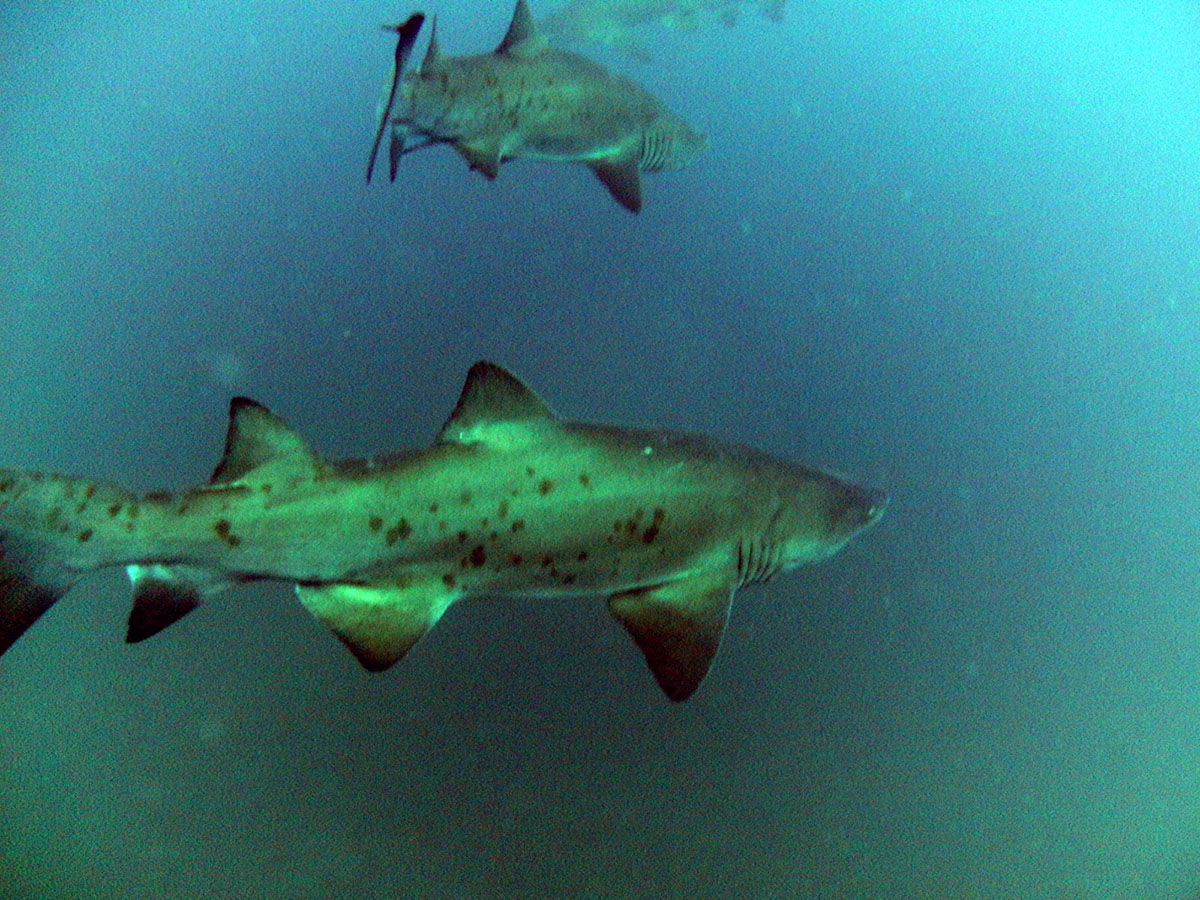Sand tiger shark
Odontaspis taurus or Eugomphodus taurus or Carcharias taurus

Sand Tiger Shark. Photos courtesy of Jim Stewart and Sandra Fazakas, 2009

Photos courtesy of Jim Stewart and Sandra Fazakas, 2009
Description
The sand tiger shark has a stout body with two large dorsal fins that are almost equal in size, with the first dorsal fin placed far back on the trunk of the body. The tail has an elongated upper lobe and no caudal keel. This shark appears bronze from above but is increasingly pale below. Juveniles have reddish or yellow-brown spots on the tail and rear end of the body that fade with age. The gill slits are anterior to the origin of the pectoral fins. Large teeth are arranged in three rows on each side of the upper jaw midline. The teeth themselves have long smooth, narrow-edged cusps with one or two small lateral denticles. This shark is able to achieve neutral buoyancy and hover in the water by storing surface air in its stomach. While menacing in appearance, this shark is generally considered to be harmless.
Range
The sand tiger shark is found in the eastern and western Atlantic, the Pacific and Indian Oceans and in the Mediterranean and Adriatic Seas. In the North Atlantic it ranges from the Gulf of Maine to Florida and into the Gulf of Mexico. There have only been three reported sightings of the sand tiger shark in Canadian waters. These sightings were in the Minas Basin of Nova Scotia, near St. Andrews, New Brunswick and off Point Lepreau, New Brunswick.
Habitat
The sand tiger shark is often found in sandy coastal waters, shallow bays, estuaries and rocky or tropical reefs. Although most often found in shallow waters they also swim down to depths of 200 meters. They are sometimes seen resting on the bottom and have the ability to remain motionless while floating in the water column by use of buoyancy control.
Life History
The maximum length attained for the sand tiger shark is 3.2 meters (10.5 feet), although the usual size is between 1.2 and 2.7 meters in length. It is a migratory species, inhabiting shallow coastal waters in the summer and moving to deeper or southern waters in the winter.
Diet
Diet consists mainly of large and small bony fish, small sharks, rays, squid and crustaceans. It is a voracious eater and its teeth are adapted for eating small prey.
Reproduction
The sand tiger is ovoviviparous, bearing 2 live young after a gestation period of 9 to 12 months. Each pup is approximately 91-105 cm and is usually born in the winter. In each of the two separate uterine chambers the first embryo to hatch obtains its food by eating the other developing eggs. Females mature between 220 and 240cm
Interaction with People
Generally harmless unless provoked, it is not considered a threat but is often encountered by divers in other parts of the world. With its fierce look and ability to adapt to captivity it is a popular shark in many aquariums.
Distinguishing Characteristics
- Often swims with mouth open
- Two dorsal fins almost equal in size
- Caudal fin with elongated upper lobe
and prominent subterminal notch - Juveniles have yellow-brown spots.
- Date modified: